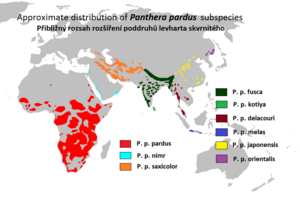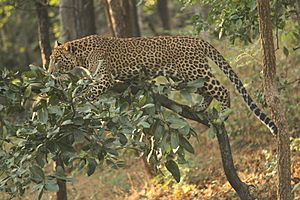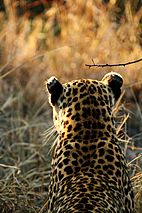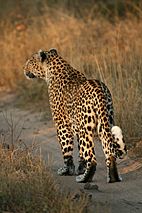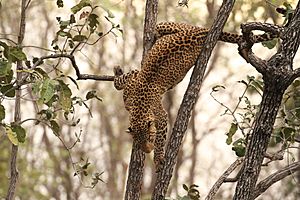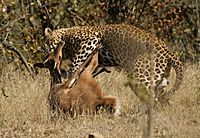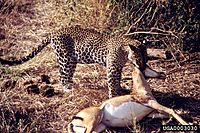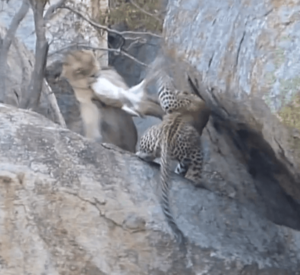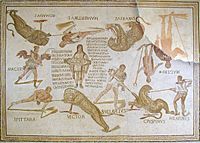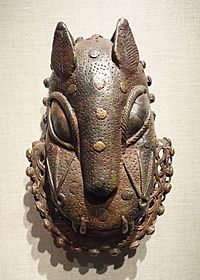Leopard facts for kids
Quick facts for kids Leopard |
|
|---|---|
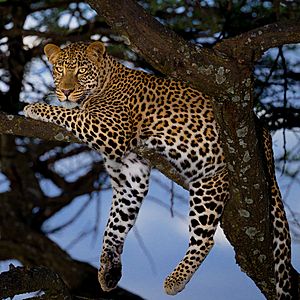 |
|
| A male African leopard in Maasai Mara National Reserve, Kenya. |
|
| Conservation status | |
| Scientific classification | |
| Subspecies | |
|
See text |
|
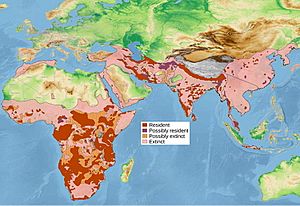 |
|
| Where leopards live now and where they used to live. |
The leopard (Panthera pardus) is a type of wild cat. Its name comes from ancient Greek words meaning 'spotted lion'. Leopards have a yellowish to dark golden fur with dark spots. These spots are grouped in patterns called rosettes.
Scientists first described the leopard in 1758. Today, there are eight types of leopards, called subspecies. They live in many places across Africa and Asia.
Leopards can live in many different places. These include rainforests, open steppes, dry areas, and mountains. They are clever hunters, eating mostly hoofed animals (like deer) and primates (like monkeys). Their spotted fur helps them hide and surprise their prey. Sometimes, they even drag their food up a tree!
Leopards usually live alone, except when they are mating or raising their young. Female leopards typically have 2 to 4 cubs every 15 to 24 months. Both male and female leopards are ready to have babies when they are about 2 to 2.5 years old.
The leopard is listed as a Vulnerable animal. This means its numbers are going down. Leopards are in danger because their homes are being lost and broken up. This is called habitat loss and fragmentation. Leopards have also been important in the cultures of Ancient Greece, West Africa, and modern Western countries. Their skins were once popular in fashion.
Contents
What Leopards Look Like
Leopards have strong, slender bodies with good muscles. They are usually about 92 to 183 centimeters (3 to 6 feet) long. They stand about 60 to 70 centimeters (2 feet) tall. Their tail is quite long, around 66 to 102 centimeters (2 to 3.3 feet).
Male leopards typically weigh between 30.9 and 72 kilograms (68 to 159 pounds). Females are a bit smaller, weighing 20.5 to 43 kilograms (45 to 95 pounds).
A leopard's fur is soft and thick. In colder places, their fur might be grayish. In rainforests, it can be a dark golden color. Each leopard has unique rosette patterns, just like human fingerprints. The spots fade to white on their belly and the inside of their legs.
Where Leopards Live
Leopards live in more places than any other wild cat. You can find them across Africa, the Caucasus mountains, and Asia. However, their populations are spread out and getting smaller. They mostly live in savannas and rainforests. They also like areas with grasslands, woodlands, and forests near rivers. In sub-Saharan Africa, many leopards still survive in places where other big cats have disappeared.
In the Far East of Russia, leopards live in temperate coniferous forests. Here, winter temperatures can drop to a very cold −25°C (−13°F).
Leopard Behavior
Leopards are usually shy and careful. They are territorial animals, meaning they protect their own space. They are often alone, except when it's time to mate. If they feel threatened, they might attack people or other animals.
Female leopards stay connected with their cubs even after the cubs stop drinking milk. They have even been seen sharing food with their young if the cubs can't find prey. Leopards make many sounds, like growls, snarls, meows, and purrs. Their roar sounds like a "sawing" noise. Young cubs make an urr-urr sound to call their mother.
Some scientists think the white tips on a leopard's tail might be a "follow-me" signal. This could help them communicate with other leopards.
Leopards are most active from evening until morning. They rest during the day and some hours at night. They hide in thick bushes, among rocks, or on tree branches. Leopards have been known to walk 1 to 25 kilometers (0.6 to 15.5 miles) at night. If they are disturbed, they might wander up to 75 kilometers (46.6 miles).
Hunting and Diet
The leopard is a carnivore, meaning it eats meat. It prefers to hunt medium-sized animals. Some of its favorite prey are hoofed animals like impalas, bushbucks, and chitals. They also hunt primates such as white-eyelid mangabeys and gray langurs. Leopards can even hunt smaller meat-eaters like black-backed jackals and cheetahs.
Leopards use their excellent hearing and eyesight to hunt. They usually hunt at night in most areas. However, in some forests in western Africa and Tsavo National Park, they have been seen hunting during the day. They typically hunt on the ground. In the Serengeti, they have been observed surprising prey by jumping down from trees.
A leopard will sneak up on its prey, getting as close as possible, usually within 5 meters (16 feet). Then, it pounces and kills the animal. For small prey, it bites the back of the neck. Leopards can carry their kills up to 2 kilometers (1.2 miles) away. They have very strong jaw muscles, allowing them to drag animals heavier than themselves up into trees. This helps them keep their food safe from other animals.
Male leopards eat about 3.5 kilograms (7.7 pounds) of meat per day. Females eat about 2.8 kilograms (6.2 pounds) daily. In the southern Kalahari Desert, leopards get their water from the fluids in their prey. They also eat juicy plants like gemsbok cucumbers and watermelon. They drink water every two to three days.
Leopard Enemies and Competitors
In some areas, leopards share their homes with other large predators. These include tigers, lions, cheetahs, spotted hyenas, African wild dogs, and even some bear species. Some of these animals might steal a leopard's food, kill its cubs, or even attack adult leopards. Leopards generally try to avoid adult bears and large groups of African wild dogs.
In the Kalahari Desert, leopards often lose their kills to brown hyenas. This happens if the leopard cannot move its food up a tree. Single brown hyenas have been seen chasing away male leopards from their kills. Lions also sometimes take leopard kills from trees.
Where both leopards and tigers live, tigers tend to stay in the deeper parts of the forest. Leopards are then found closer to the edges. In tropical forests, leopards and tigers can live together. They hunt at different times and choose different sizes of prey.
Nile crocodiles have also been known to hunt leopards.
Leopard Life Cycle
In some places, leopards can mate all year round. In colder areas like Manchuria and Siberia, they mate in January and February. Females usually start having cubs when they are 2.5 to 3 years old. Males are ready to mate when they are 2 to 3 years old.
A female leopard typically gives birth to a litter of 2 to 4 cubs. Sadly, about 41–50% of cubs do not survive their first year. Lions and spotted hyenas are the main reasons for cub deaths. Females usually have new cubs every 15 to 24 months. This time can be shorter if the previous cubs do not survive.
Mothers give birth in a safe place, like a cave, a crack in rocks, a hollow tree, or a thick bush. Newborn cubs weigh between 280 and 1000 grams (0.6 to 2.2 pounds). They are born with their eyes closed, which open 4 to 9 days later. Young cubs have longer, thicker fur than adults. Their fur is also more gray with less clear spots.
Cubs start eating meat when they are about nine weeks old. Around three months of age, they begin to follow their mother on hunts. By one year old, cubs can probably hunt for themselves. However, they usually stay with their mother for 18 to 24 months. After leaving their mother, cub siblings might travel together for a few months.
Leopard Conservation
The leopard is listed in CITES Appendix I. This means that trading leopard skins and body parts is very limited. Only 2,560 individuals from 11 countries in sub-Saharan Africa can be traded.
The biggest threats to leopards are habitat fragmentation and forests being turned into farmland. This means less natural prey for them. It also leads to problems with people who raise livestock, which can cause leopards to be killed. Trophy hunting and poaching (illegal hunting) are also big dangers. Today, leopards live in only about 25% of the areas they used to.
Leopards are now considered to be completely gone from some places. These include Hong Kong, Singapore, South Korea, Jordan, Morocco, and many other countries.
Leopards and Humans
Cultural Significance
Leopards have appeared in art, myths, and stories in many cultures. In Greek mythology, the leopard was a symbol of the god Dionysus. He was often shown wearing leopard skin or riding leopards. In one myth, two leopards saved him from pirates.
During the Benin Empire, leopards were often shown in carvings and sculptures. They symbolized the power of the king, or oba, because the leopard was seen as the king of the forest. The Ashanti people also used the leopard as a symbol of leadership. Only the king was allowed to have a special leopard stool. Some African cultures believed the leopard was a smarter and better hunter than the lion.
In Rudyard Kipling's "How the Leopard Got His Spots," from his Just So Stories, a leopard without spots lives with his friend, the Ethiopian. When they move to the forest, the Ethiopian changes his skin color, and the leopard gets his spots. A leopard also played an important role in the 1938 Hollywood movie Bringing Up Baby.
The leopard is often used in heraldry, which is the study of coats of arms. It usually appears as a "passant" leopard, meaning it is walking with one paw raised. In heraldry, the leopard often looks like a lion and doesn't have spots. This is why they are sometimes used in the same way. Real-looking leopards appear on the coat of arms of Benin, Malawi, Somalia, the Democratic Republic of the Congo, and Gabon. Gabon's coat of arms even shows a black panther.
Leopards in Captivity
The ancient Romans kept leopards in captivity. They were used in hunts and sometimes in executions of criminals. In Benin, leopards were kept as mascots and used in parades and sacrifices to gods.
In the 13th century, King John of England had several leopards in a zoo at the Tower of London. Around 1235, three of these leopards were given to Henry III by Holy Roman Emperor Frederick II. In modern times, leopards have been trained and tamed for circuses.
Interesting Facts About Leopards
- The leopard is one of the five living species in the Panthera group of big cats.
- It likely first appeared in Africa about 0.5 to 0.8 million years ago. Then, it spread across Asia about 0.2 to 0.3 million years ago.
- The name 'leopard' (λέοπάρδος) was originally given to a cheetah.
- Leopards with all black fur are known as black panthers.
- The heaviest wild leopard ever recorded in Southern Africa weighed about 96 kilograms (212 pounds).
- The largest leopard skull ever found was in India in 1920. It was 28 centimeters (11 inches) long and weighed 1 kilogram (2.2 pounds).
- Leopards are very good at climbing trees. They often rest on branches and can climb down headfirst.
- They can run over 58 kilometers per hour (36 mph). They can also leap over 6 meters (20 feet) horizontally and jump up to 3 meters (10 feet) vertically.
- The average life span of a leopard is 12 to 17 years.
- The oldest leopard ever recorded was a female in captivity. She lived to be 24 years, 2 months, and 13 days old.
- In 1953, a male leopard and a female lion were crossbred in Japan. Their babies, called leopons, were born in 1959 and 1961. All the cubs had spots and were bigger than young leopards.
See also
 In Spanish: Leopardo para niños
In Spanish: Leopardo para niños






